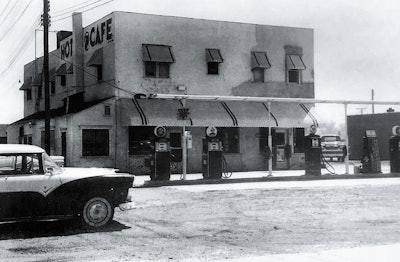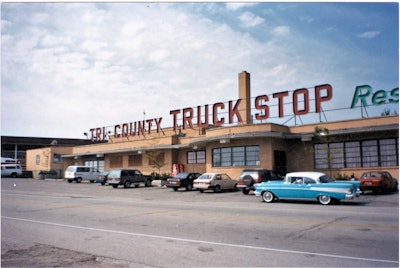 Trucker’s Home in Arlington, Missouri, “was nothing but a café with a jukebox in the corner and a couple of cabins,” said postcard collector Joe Sonderman.
Trucker’s Home in Arlington, Missouri, “was nothing but a café with a jukebox in the corner and a couple of cabins,” said postcard collector Joe Sonderman.

And therein was the seed of what came to be his true love – postcards of highway businesses. In particular, postcards from the old days of U.S. Route 66. He’s now got 10,000 postcards that document the motels, diners, truck stops and gas stations of the highway’s glory years, from its beginnings in 1926 to the late ‘50s, as the new interstate highway system began to bypass it.
“Postcards a lot of times are the only photos of a lot of these places,” Sonderman said. “People didn’t take pictures of hotels, of mom-and-pop joints. But postcards were common.”
 “Nostalgiaville is no place to live,” said Joe Sonderman, who acknowledges the value of the interstate highway system, “but it's nice to visit it occasionally.”
“Nostalgiaville is no place to live,” said Joe Sonderman, who acknowledges the value of the interstate highway system, “but it's nice to visit it occasionally.”

His website has images of thousands of historic postcards showing the highway’s attractions. You can search the archive by state and easily click through slide shows of the photos.
Route 66 isn’t the nation’s most scenic highway, but arguably is its most iconic. Among themany cultural references, it’s popularized in a hit song, "(Get Your Kicks on) Route 66," and even a CBS Route 66 television series. It was also known as the Will Rogers Highway, the Main Street of America or the Mother Road. It originally ran from Chicago to Santa Monica, California.
 Our original story about Joe Sonderman’s Online Route 66 Archive was published in 2014. That year he published "Postcards from Route 66."
Our original story about Joe Sonderman’s Online Route 66 Archive was published in 2014. That year he published "Postcards from Route 66."
He estimates 95% of the original Route 66 is intact. Though most of the oldest establishments are gone or remodeled, the mystique still attracts visitors.
“If you stop and learn the history of these places, every one has a story,” Sonderman said. “It’s a story of a family trying to earn a living. And one day that interstate comes along and it’s all gone.”
 “You could call a place a truck stop if it had two pumps and cabins,” Sonderman said, citing the Powellville Cafe, in Powellville, Missouri, as an example. It was built by the Powell brothers, who ran a major Midwestern fleet.
“You could call a place a truck stop if it had two pumps and cabins,” Sonderman said, citing the Powellville Cafe, in Powellville, Missouri, as an example. It was built by the Powell brothers, who ran a major Midwestern fleet.
Below are other postcards from Sonderman's collection showing truck stops from decades ago on Route 66.
 The Five Star Truck Stop in Bloomington, Illinois.
The Five Star Truck Stop in Bloomington, Illinois.
 Caldwell Truck Stop in Lebanon, Missouri.
Caldwell Truck Stop in Lebanon, Missouri.
 The Diamonds, in Villa Ridge, Missouri.
The Diamonds, in Villa Ridge, Missouri.
 The Dixie Trucker's Home in McLean, Illinois (above and below).
The Dixie Trucker's Home in McLean, Illinois (above and below).

 Grant’s Truck & Car Stop, at the Arizona-New Mexico border.
Grant’s Truck & Car Stop, at the Arizona-New Mexico border.
 The Pure Truck Station in Towanda, Illinois.
The Pure Truck Station in Towanda, Illinois.
 The Quonset, in Fenton, Missouri.
The Quonset, in Fenton, Missouri.
 Pete & Sons Place in Amarillo, Texas.
Pete & Sons Place in Amarillo, Texas.
 Welco Corners in Will County, Illinois.
Welco Corners in Will County, Illinois.













